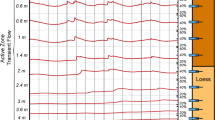Abstract
Intensive experimental as well as numerical investigations have been carried out in order to develop empirical relationships to predict wetting front travel time and infiltration rate in deep arid region alluvium due to the effect of variable rainfall intensity and ponding head, respectively. A rainfall simulator that is capable of producing variable rainfall intensity up to 160 mm/h and a large diameter infiltrometer were constructed in the study area and then used to test the effect of rainfall and ponding head up to a depth of 3 m. Results of these experiments were utilized to calibrate an unsaturated zone model which was then used to test different scenarios for wetting front movement at depths beyond the scope of these experiments. Empirical infiltration relationships for rainfall and ponding head, respectively, were derived for shallow and deep soil columns from these experiments.










Similar content being viewed by others
References
Bernadiner MG (1998) A capillary microstructure of the wetting front. Transp Porous Med 30:251–265
Brooks RH, Corey AT (1964) Hydraulic properties of porous media: Hydrology Papers No. 3, Colorado State University, Fort Collins, p 27
Dahan O, Tatarsky B, Enzel Y, Kulls C, Seely M, Benito G (2008) Dynamics of flood water infiltration and ground water recharge in hyperarid desert. Ground Water 46(3):450–461
Dahan O, Talby R, Yechieli Y, Adar E, Lazarovitch N, Enzel Y (2009) In situ monitoring of water percolation and solute transport using a vadose zone monitoring system. Vadose Zone J 8:916–925
Dillah D, Protopapas AL (2000) Uncertainty propagation in layered unsaturated soils. Transp Porous Med 38:273–290
Gvirtzman H, Shalev E, Dahan O, Hatzor YH (2008) Large-scale infiltration experiments into unsaturated stratified loess sediments: monitoring and modeling. J Hydrol 349(1–2):214–229
Haim D, Shechter, M, Berliner P (2008) Assessing the impact of climate change on representative field crops in Israeli agriculture: a case study of wheat and cotton. Climatic Change 86:425–450
Haverkamp R, Vauclin M, Tovina J, Wierenga PJ, Vachud G, (1977) A comparison of numerical simulation models for one-dimensional infiltration. Soil Science Society of America Proceedings 41:285–294
Hsieh P, Wingle W, Healy RW (2000) VS2DI-A Graphical software package for simulating fluid flow and solute or energy transport in variably saturated porous media: U.S. Geological Survey Water Resources Investigation Report 9, 9-4130
Kacimov AR, Al-Ismaily S, Al-Maktoumi A (2010) Green-Ampt one-dimensional infiltration from a ponded surface into a heterogeneous soil. J Irrig and Drain Engrg 136(1):68–72
Lappala EG, Healy RW, Weeks EP (1987) Documentation of computer program VS2D to solve the equations of fluid flow in variably saturated porous media: U.S. Geological Survey Water Resources Investigation Report 83-4099, 184p
Ochoa CG, Fernald AG, Guldan SJ, Shukla MK (2009) Water movement through a shallow vadose zone: a field irrigation experiment. Vadose Zone J 8:414–425
Philip JR (1957) The theory of infiltration: the profile at infinity. Soil Sci 83:435–448
Stone JJ and GB Paige (2003) Variable rainfall intensity rainfall simulator experiments on semi-arid rangelands. Renard, K.G., McElroy, S.A., Gburek, W.J., Canfield, H. E. and Scott, R. L., eds. First Interagency Conference on Research in the Watersheds, October 27–30, 2003. US Department of Agriculture, Agricultural Research Service
Thiam-Soon T, Fook-Hou L, Poh-Ting C, Hiroyuki T (2004) Effect of Sampling Disturbance on Properties of Singapore Clay. J Geotech and Geoenviron Eng 130, 116 (2004); doi:10.1061/(ASCE)1090-0241
Timlin D, Pachepsky Y (2002) Infiltration measurement using a vertical time-domain reflectometry probe and a reflection simulation model. Soil Sci 167(1):1–8
van Genuchten M.Th. (1980) A closed-form equation for predicting the hydraulic conductivity of unsaturated soils. Soil Sci Soc Am J 44:892–898
Wang Z, Feyen J, van Genuchten M, Nielsen DR (1998) Air entrapment effects on infiltration rate and flow instability. Water Resour Res 34(2):213–222
Wayllace A and Likos WJ (2006) Numerical modelling of soil–atmosphere interaction for unsaturated surfaces. Proceedings of the Fourth International Conference on Unsaturated Soils, April 2–6, Carefree, Arizona
Wilcox BP, Wood MK, Tromble JT and Ward TJ (1986) A hand-portable single nozzle rainfall simulator designed for use on steep slopes. Journal of Range Management, 39 (4)
Wood WW, Sanford WE (1997) Chemical and isotopic methods for quantifying groundwater in a regional semiarid environment. Groundwater 33:458–468
Wu, Jinquan, Zhang, Renduo, Wang, Jinzhong (1996) Analysis of rainfall–recharge relationships. J Hydro 177:143–160
Acknowledgement
The work done in this paper has been carried out as part of a project entitled “Rehabilitation of galleries of Zubaidah”, supported by the Governor Office of Makkah Al-Mukarammah Area. The authors would like to express their great gratitude to the office and Dr. Omar Aburizaiza for their financial and logistical support.
Author information
Authors and Affiliations
Corresponding author
Rights and permissions
About this article
Cite this article
El-Hames, A.S., Al-Wagdany, A.S. Investigation of wetting front behavior due to rainfall and ponding head effects in arid region wadi alluvium. Arab J Geosci 6, 1499–1507 (2013). https://doi.org/10.1007/s12517-011-0457-6
Received:
Accepted:
Published:
Issue Date:
DOI: https://doi.org/10.1007/s12517-011-0457-6




